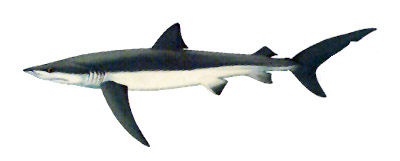 |
 |
 |
 |
 |
 |
 |
 |
 |
 |
 |
 |
 |
 |
 |
 |
 |
 |
 |
 |
 |
 |
 |
 |
 |
 |
 |
 |
 |
 |
 |
 |
 |
 |
 |
 |
 |
 |
 |
 |
|
|
 |
|
|
|
 |
|
 |
|
|
|
Blue Shark |
|
|
|
|
|
|
|
 |
|
|
|
|
|
|
|
Distribution: |
|
|
|
|
|
The Blue Shark is a deep water offshore species that is mainly assosiated with the West and South coasts. Fish usually average at around 100 lb and peak at 200lb although it seems as they grow larger they move away from temperate waters and the much larger fish to 900lb and 1000 lb are to be found in tropical seas. Galway and Donegal are noted for their Blue Shark populations, as is Kilmore key and the Saltee islands. Kerry and Cork are also noted for their catches. |
|
|
|
|
|
|
|
|
|
|
|
Habitat: |
|
|
|
|
|
The Blue Shark is a deep water species. It prefers to swim mid water following warm currents and bait fish and Squid. In more tropical waters it can often be found more deep near the bottom searching over both reefs and sandy bottoms. 'Blues' when found off our coastline, are usually found feeding on the large shoals of Mackeral. |
|
|
|
|
|
|
|
|
|
|
|
Season: |
|
|
|
|
|
In Ireland the Blue Shark is strictly a high summer species. As the water starts to cool down they move off out into the Atlantic. The season really begins in May if the weather has had time to warm the water up sufficently and continues into September with prime time being June and July. |
|
|
|
|
|
|
|
|
|
|
|
Baits: |
|
|
|
|
|
Whole Mackeral flappers are the order of the day. Herring is also a good bait if you can get it. In the Wild other food on the menu are Cod, Haddock, Squid, Pollock and Hake. |
|
|
|
|
|
|
|
|
|
|
|
Tides and Weather: |
|
|
|
|
|
The Blue Shark does not seem too bothered by Rough weater although sunny days or periods of good weather are much more likely to put the Sharks on the feed as their metabilism speeds up in the warmer water. More Sharks tend to be caught during calmer periods but this is probably more due to the fact that charter boats are more likely to fish offshore in these periods. |
|
|
|
|
|
|
|
|
|
|
|
Tactics: |
|
|
|
|
|
Although Blue Sharks seem to like the deeper waters off the coast it seems that they are generally mid water swimmers unlike the Tope. Fishing for them is really an offshore business and best approached as a charter trip. Like all sharking, fishing for Blues requires lots of patience often with little results. Putting the time in however, is the only way you will have a chance. You must be prepared to sit around for hours at a time again and again to truly be in with a chance. Fishing for blues In tropical waters is hectic business often with strong outfits. Here in Ireland, Blues are more sluggish due to the colder water slowing their metabilism and a 30lb outfit with a 4/0 reel is adequete. A good supply of Rubby Dubby is a must! and should be fed contiually from the back of the boat through a 'feeder'. This obviously means a good supply of mackeral is needed with about 32 KG being both ample for both bait and chum. Baits are streamed astern - generally two or three Mackeral fishing about 30 yrd behhind the boat where the shallowest will be., the deeper baits further back.Each should be seperated by about 10 yards as to reduce tangles. The baits are set to fish at different depths with about one fathom between each. traces are susspended by tieing thread round the line at the selected depth. this is then tied to a partially inflated childs balloon. Each angler should fish using a different colour. these should be inflated no bigger than a grapefruit as a shark may be spooked by the drag it creates and drop the bait. A whole Mackeral is ample as bait. Reels should be kept in free spool and thumbed until the fish stops running. at this stage he will be turning with the bait in his mouth and at this stage is when you strike. Reel in the slack and take up the thump. During the first run keep pressure on your thumb so as to make sure the hook sets propperly and from there on allow him to take line fighting both the rod and reels drag until tired enough to bring to the boat. Sharks should always be hauled aboard by tailing either by hand if that is possible or with a stick with a loop of rope as a noose on the end. The Sharks eyes should be covered with a cloth to prevent him thrashing about while on deck. |
|
|
|
|
|
|
|
|
|
 |
|
|
|
|
|
 |
|
|
|
|
|
|
|
|
|
|
|
Blue Shark chasing a shoal of Mackeral |
|
|
|
|
|
Blue Shark Profile |
|
|
|
|
|
|
|
|
|
|
|
Back to Species List |
|
|
|
|
Back to Home Page |
|
|
|
|
|
|
|
|
|
|
|
|
 |
|





